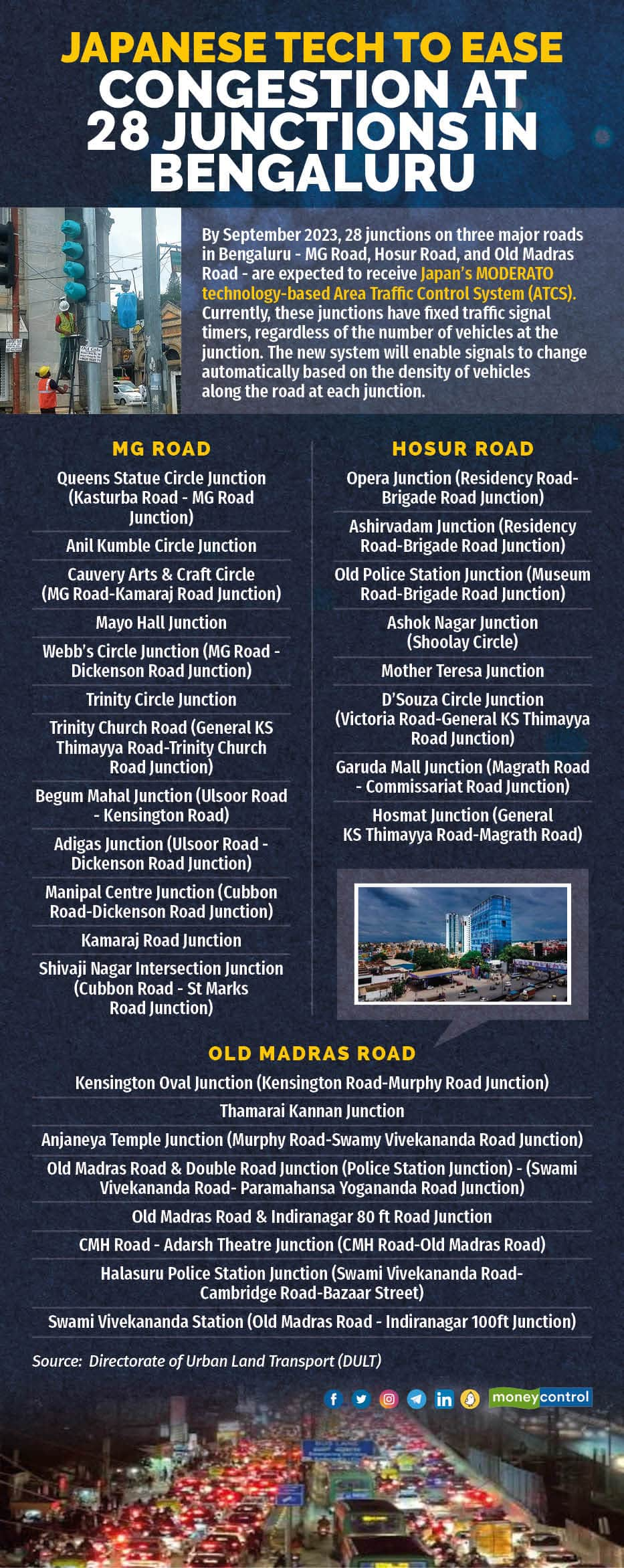



For a few weeks every year, Bengaluru and Japan wear pink canopies of flowers. If it's cherry blossoms in Japan, Bengaluru has the Tabebuia Rosea trees in bloom during spring. Now, both places will have one more thing in common.
In a first in India, Japan’s MODERATO (Management of Origin-Destination-Related Adaptation for Traffic Optimization) technology is being implemented in the country's tech capital. This will help reduce traffic congestion at signals on three major roads and factors in a pedestrian crossing.
If you are commuting on Bengaluru’s MG Road, Hosur Road, and Old Madras Road, you might have seen new traffic signals and new pole installations at traffic intersections. Japan's MODERATO is likely to be implemented at major junctions in core city areas by the end of September.
However, this adaptive traffic signal control system will not cover the city's 10 major congested junctions – Silk Board, Ibballur, Kadubeesanahalli, Dairy Circle, Tin Factory, Hebbal, Goraguntepalya, Sarakki, Banashankari, and Kumaraswamy Layout.

"This project is a pilot demonstration of the Area Traffic Control System (ATCS) using the MODERATO application with grant-in-aid from the Government of Japan. As per the grant agreement, the scope of signal implementation was limited to 29 junctions. The list of junctions was finalised in consultation with the Bengaluru traffic police," V Manjula, Commissioner, Directorate of Urban Land Transport (DULT) told Moneycontrol.
Sources said the project was first announced in 2014, but gained momentum only in July 2021. While it was supposed to be completed by October 2022, it has already missed multiple deadlines.
"These junctions were identified before 2014, but now the major congestion is not in the Central Business District but on Outer Ring Road and in the outskirts. However, it was difficult to change the plans since it was JICA funded," said a source.
A traffic expert said, "This technology has a proven track record in Japan, which improves the efficiency of traffic signals. Unlike ad-hoc random signal systems, this project is corridor-based, which holds the potential for better results".
"But this is a pilot project, and Indian conditions are different. For example, Bengaluru has a higher proportion of two-wheelers compared to Japan. Also, traffic police manually operate signals to allow emergency vehicles or during VIP movements. Unlike in Japan, there is no RFID and GPS-based automatic lane clearance system for emergency vehicles like ambulances in Bengaluru. In foreign cities, when RFID-tagged emergency vehicles such as ambulances, fire engines, and police vehicles approach a traffic signal, it turns to green light and allows their smooth passage. In Indian cities, signals are manually operated during such instances" he said.
"The adaptive signal control technology will be able to reduce congestion and optimise waiting times at signals. But traffic police should also be involved in the planning and testing to yield better results. Handing over the project only after the completion without proper testing will affect the success and there should be proper coordination between the DULT and traffic police. This could be expanded to other arterial roads, based on the outcome of this pilot project" he said.
Reduction in traffic jamsDULT officials said that once implemented, there will be a reduction in traffic jams in these junctions. "This project was supposed to cover 29 junctions. As per the revised plan, 28 junctions are being taken up. One junction has been dropped due to ongoing Metro work. The installation work of ATCS at all 28 junctions like laying the foundation, cabling, pole erection, is under progress," said Manjula.

"Under ideal conditions (without any road construction or obstructions on road arms leading to the junction), it is envisaged that the delays at junctions in the project area would be reduced by 13 percent, and queuing reduced by 30 percent. The main components of ATCS include signal arms and aspects for motorists and pedestrians, an Automatic traffic counter and classifier for measuring vehicular movement, and a queue-length measurement System at critical junctions for monitoring queue build-up. A central control software (MODERATO) will be used for real-time optimisation of signal phasing and timings for all junctions as part of this project," said Manjula.
The project is estimated to be completed by the end of September 2023. Once the implementation is completed, the ATCS will be handed over to the Bengaluru traffic police for operations and maintenance, said Manjula. She further pointed out that though signals will work in automated mode, provision has been made in the system to switch to manual operation to facilitate the movement of emergency vehicles. The Rs 70-crore project is funded by the Japanese International Cooperation Agency (JICA), and Japanese firm Nagoya Electric Works Co. Ltd is implementing it.
Traffic police plan adaptive traffic signal control in 482 junctionsBengaluru has nearly 40,000 traffic intersections, out of which 388 are controlled by signals, and 500 are manually regulated. Joint commissioner of police (Bengaluru traffic) MN Anucheth told Moneycontrol: "We are in the process of implementing an adaptive traffic signal control system in 482 junctions. This project excludes the 28 junctions where Japanese traffic signal technology is currently being piloted by the DULT."
Anucheth said the adaptive traffic signal control system will be implemented in three phases. "We are awaiting approval from the state government to float the tender for Phase 1 of the project, which will cover 165 junctions. Phase 2 will include 221 junctions, while the remaining junctions will be covered in Phase 3" he added.
Discover the latest Business News, Sensex, and Nifty updates. Obtain Personal Finance insights, tax queries, and expert opinions on Moneycontrol or download the Moneycontrol App to stay updated!
Find the best of Al News in one place, specially curated for you every weekend.
Stay on top of the latest tech trends and biggest startup news.